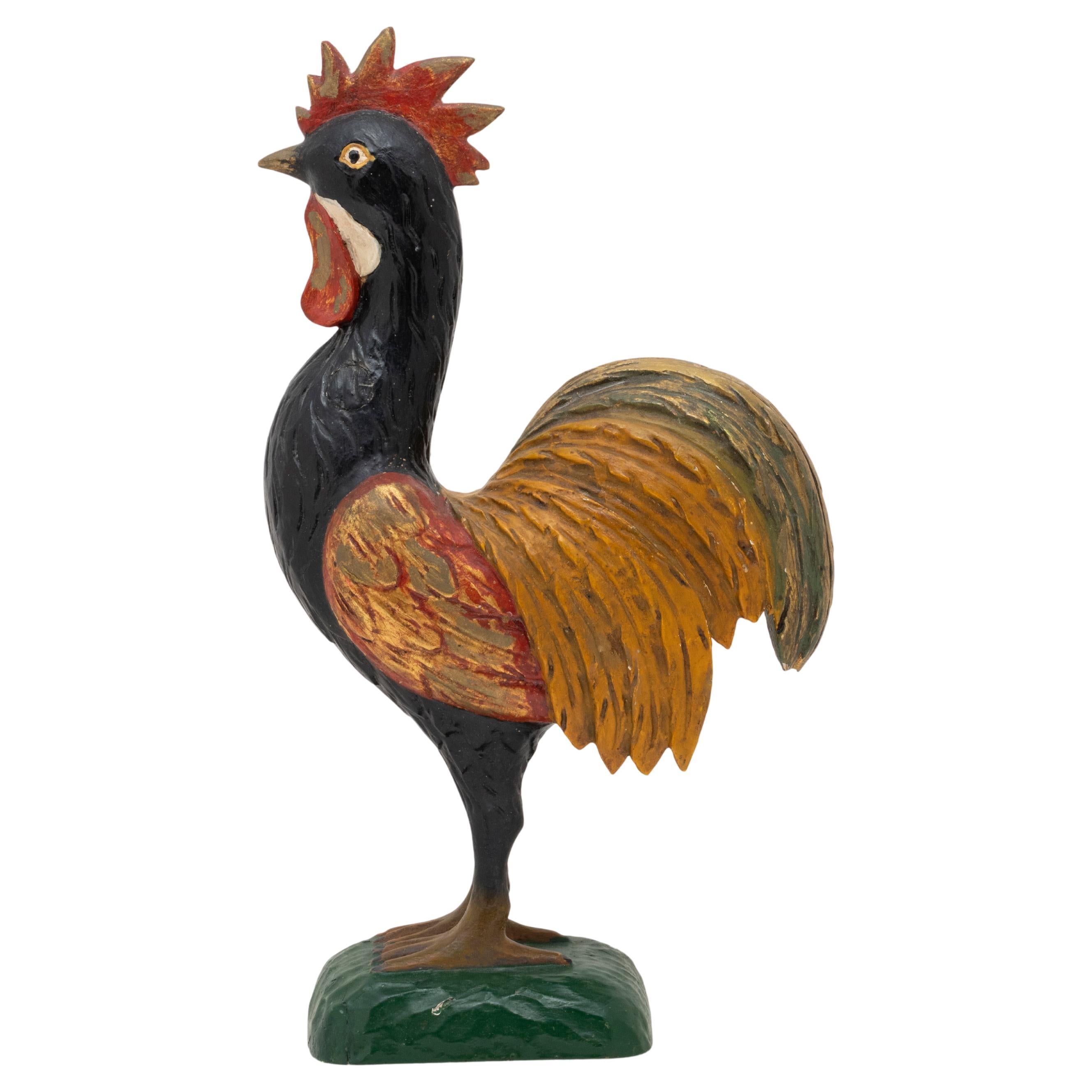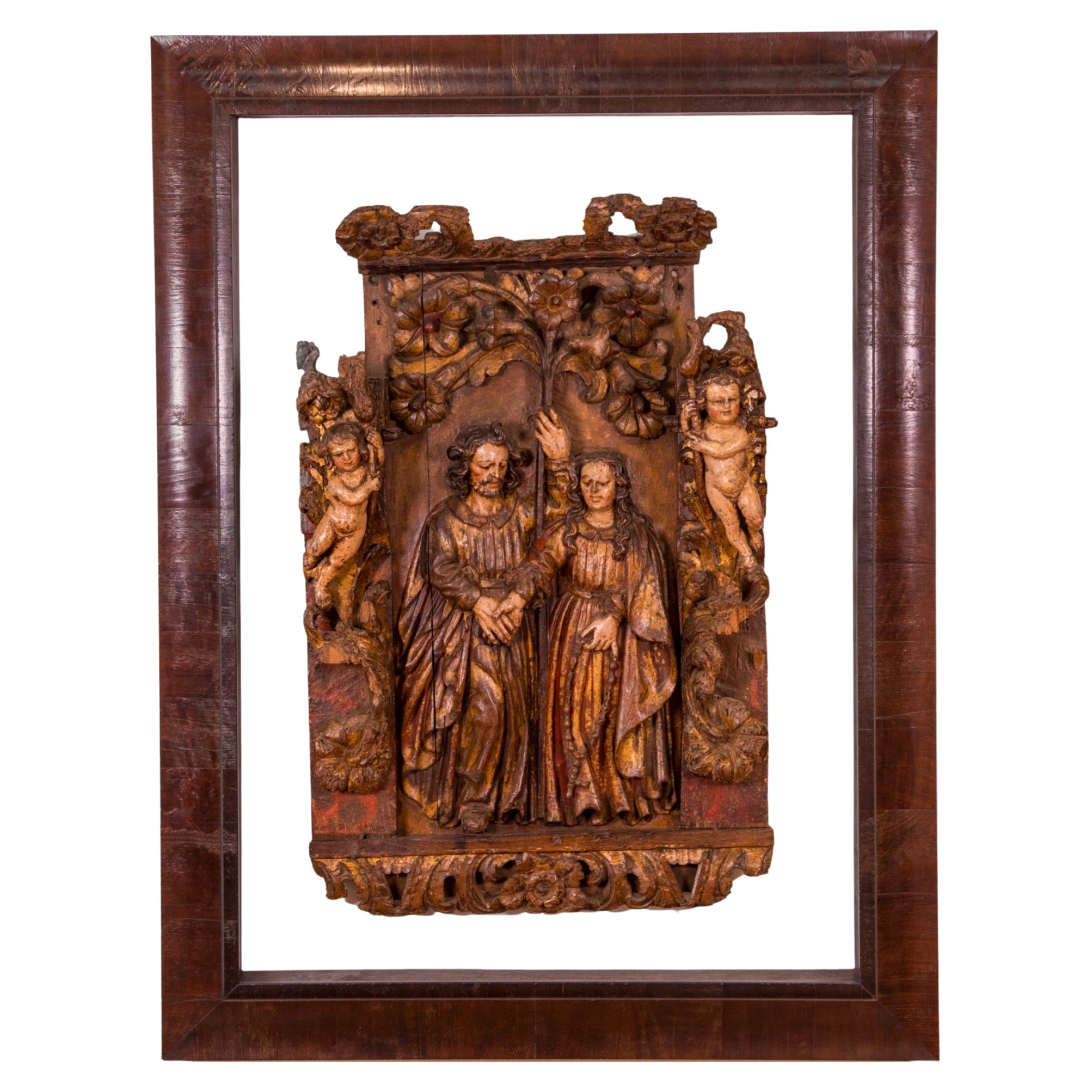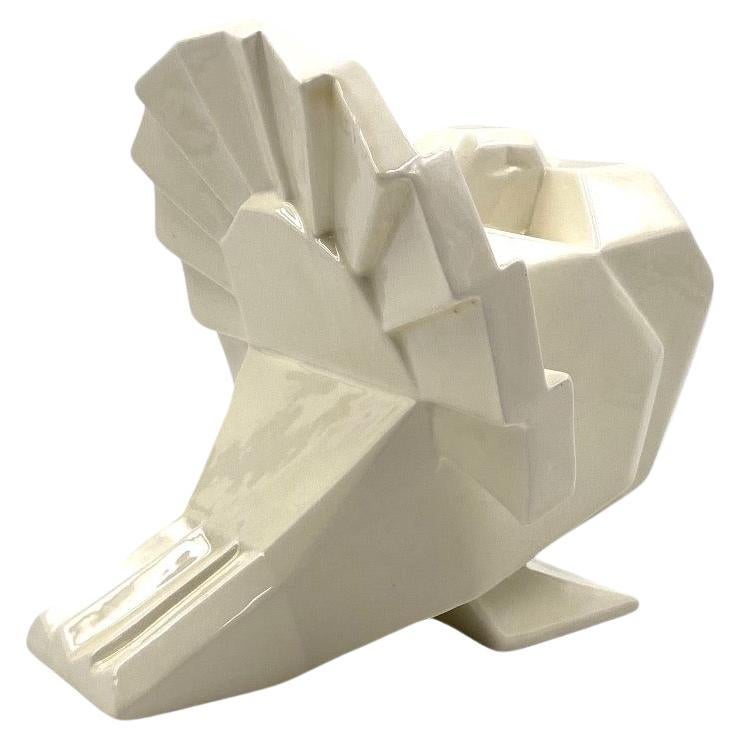Items Similar to Allan Clark, the King's Temptress, Carved and Polychromed Mahogany, ca. 1926/27
Want more images or videos?
Request additional images or videos from the seller
1 of 8
Allan Clark, the King's Temptress, Carved and Polychromed Mahogany, ca. 1926/27
About the Item
ABOUT SCULPTURE
This unusual colorful sculpture depicts a very beautiful Balinese woman with a dance crown on her head, looking straight at the viewer. Squinted eyes and slightly swollen lips make her expression sensual and unequivocally inviting. Judging by the author's name of the sculpture, "The King's Temptress", the seduction is directed at her master and lover, the king himself!
Many of Clark's sculptures reveal his interest in the exotic or foreign, though these elements, such as Asiatic features, Far Eastern clothing, or romantic titles, are usually superficial additions to figures that are directly related to the idealized and decorative Art Deco figures being created by Clark's contemporaries.
Though Clark was praised during his lifetime for how well he had assimilated Asian elements into his work, more recent critiques have noted his often superficial use of Asiatic and Native American ethnic traits and his regular equation of the fantastic and erotic with non-Western cultures. Though Clark's work does clearly reflect early twentieth century stereotypes, there are elements in his work that indicate that he assimilated more than the surface details of the sculptures he studied during his travels in the Far East. Similarities can be drawn, for example, between the full, rounded body contours of Clark's figures and the sculptures of India, or his creation of realistically detailed, painted wood sculptures and the lacquered sculptures of the Nara and Kamakura periods in Japan. His use of gilding and polychromy also reflects Asian influences and techniques.
DIMENSIONS
Height: 21.75 inches
Width: 13.5 inches
Depth: 8 inches
ABOUT ARTIST
Allan Clark (American, 1896 – 1950)
Born in Missoula, Montana, Allan Clark became a sculptor whose figure work reflected his world-wide travels, especially in the Orient where from 1924 to 1927, he studied in China, Korea and Japan. Clark was also a student at Puget Sound College in Tacoma, Washington; the Art Institute of Chicago and the Art Students League in New York. Clark was a member of the National Institute of Arts and Letters, as well as the National Sculpture Society. He begun work as a sculptor in 1917 in New York City working in stone and terra cotta while teaching at the Beaux - Arts Institute of Design. After his exposure to Oriental techniques, he did woodcarving in that manner. Clark was also a member of the Fogg Museum expedition to explore cave chapels near Turkestan. From this adventure, he did 20 drawings in color. In 1930, he moved to Santa Fe, New Mexico and sculpted Indian Heads whose titles include “Maria of Cochiti” and Klah-Navaho Medicine Man.”
- Creator:Allan Clark (Sculptor)
- Dimensions:Height: 21.75 in (55.25 cm)Width: 13.5 in (34.29 cm)Depth: 8 in (20.32 cm)
- Style:Art Deco (Of the Period)
- Materials and Techniques:
- Place of Origin:
- Period:
- Date of Manufacture:circa 1926
- Condition:Wear consistent with age and use. We make our best effort to provide a fair and descriptive condition report. Please examine photos attentively, as they are an integral part of the description. Send us a message to request more details or discuss price.
- Seller Location:New York, NY
- Reference Number:1stDibs: LU2819329322792
About the Seller
5.0
Vetted Seller
These experienced sellers undergo a comprehensive evaluation by our team of in-house experts.
Established in 1993
1stDibs seller since 2017
68 sales on 1stDibs
Typical response time: 2 hours
- ShippingRetrieving quote...Ships From: New York, NY
- Return PolicyA return for this item may be initiated within 10 days of delivery.
More From This SellerView All
- Enid Bell Palanchian, Tackle, Modernist Carved Mahogany Sculpture, ca. 1953By Enid Bell PalanchianLocated in New York, NYDIMENSIONS height: 23 inches width; 12 inches depth: 6 inches MARKINGS Signed at the bottom in back. DETAILS Original hand-crafted black-painted wood plinth. REFERENCES Originally, sold to Papillon Gallery of Los Angeles. CONDITION Excellent antique condition, wear consistent with age and use. Enid Bell Palanchian (American, 1904 – 1994) a/k/a Mrs. E. B. Palanchian, Mrs. Enid Bell Palanchian and Mrs. Missak Palanchian was an important American sculptor, author, illustrator and professor who was primarily active in the New York/New Jersey area, but who established a respected body of work recognized throughout Europe and the United States as reflected by awards received in Paris, New Jersey, New York, New Mexico and Florida. Her achievements included numerous public works projects (e.g., the design of the Congressional Gold Medal) on display at public institutions and museums around the country, private commissions and sales throughout the world, group and solo exhibitions, generous donations of art and compilations, and the passing on of her knowledge and skills to 24 years of art students of the Newark School of Industrial and Fine Arts. Enid Bell was born in London, England, and later studied at the Glasgow School of Art and then at the St. John’s Wood Art School; as well as studying with fellow Scot Sir William Reid Dick in London. Then, after moving to the United States, she taught at the Art Student League in New York City at Miss Chapen’s School. Essentially a figurative, direct carving in wood artist, she was based in New Jersey where she became the head of the sculpture program of the Fedral Art Project for that state and was herself the creator of several FAP commissions. In 1932, she married Armenian/American businessman and artist, Missalk Palanchian athough she retained her name “Bell” for professional purposes. Following the end of the Federal Art Project in 1944, she taught as instructor of sculpture and Head of the Sculpture Department of the Newark School of Fine and Industrial Art until 1968, and was active was a member of the National Sculpture Society. Enid Bell died in 1994 in Englewood, New Jersey. WORK • Birds, Leonia Public Library in Leonia New Jersey (installed 1981) • Untitled, Boonton Post Office in Boonton, New Jersey (1938) • Boonton Post Office, Boonton, New Jersey • Colonizing America, Center for Youth Education, Newark, New Jersey, (1934) • Little Indian Dancer, Englewood Public Library, Englewood, New Jersey • Alexander Hamilton Troy Public Library in Troy, New York • bird bath, Music, Science, Union City...Category
Vintage 1950s American Mid-Century Modern Abstract Sculptures
MaterialsMahogany
- After The Thinker, Modern Carved Wood Sculpture, ca. 1960sLocated in New York, NYPermanently exhibited at the Musee Rodin in Paris, ‘The Thinker’ (French: Le Penseur), the original Auguste Rodin’s bronze sculpture of...Category
Vintage 1960s American Mid-Century Modern Figurative Sculptures
MaterialsWood
- French Art Deco, Lounging Nude, Carved Wood Sculpture, ca. 1930Located in New York, NYThis sculpture of a female nude was created by an unknown sculptor in the manner of the popular modernist movement in French art of the very end of the 19th century, Les Nabis...Category
Vintage 1930s French Art Deco Figurative Sculptures
MaterialsWood
- Modernist Carved Ebonized Wood Female Bust, ca. 1950Located in New York, NYThis remarkable modernist carved ebonized wood female bust, ca. 1950s with a proudly set head on an exaggeratedly elongated neck and hair flowing over the shoulders, immediately conj...Category
Vintage 1950s American Mid-Century Modern Busts
MaterialsWood
- American Art Deco Carved Slate Nude Kneeling Woman Sculpture, ca. 1920Located in New York, NYAmerican Art Deco Nude Kneeling Woman Carved Slate Sculpture ca. 1920 DETAILS Mounted on original marble base. Apparently unsigned. DIMENSIONS Hei...Category
Vintage 1920s American Art Deco Figurative Sculptures
MaterialsSlate
- Head, French Modernist Hand-Carved Wood Sculpture, ca. 1950Located in New York, NYUnusual in its conciseness and modernistic vision of a rather familiar subject - the human head - this original elegant sculpture does not leave anyone indifferent and is imprinted i...Category
Vintage 1950s French Mid-Century Modern Abstract Sculptures
MaterialsWood
You May Also Like
- Giant-Sized King's Guardsman by Kay BojesenBy Kay BojesenLocated in Sagaponack, NYA very rare and monumental giant-sized model of the Royal Danish King's Guardsman hand crafted in wood having movable arms and legs and retaining its ...Category
Vintage 1950s Danish Scandinavian Modern Toys and Dolls
MaterialsWood
- Polychrome Carved RoosterLocated in Coeur d'Alene, IDMid 20th Century American polychrome carved figure of a rooster. Beautiful colors of black, orange, red, brown, cream and green. PERIOD: Mid 20th Century ORIGIN: Unknown, United St...Category
20th Century American Animal Sculptures
MaterialsWood
- Six Very Fine Early 19th C Moulds Picturing Dutch Queen and King's FiguresLocated in Leuven , BEThese very detailed moulds were used to make bronze reliefs.Category
20th Century Unknown Busts
MaterialsStone
- Polychrome carved wood Virgin and Child from the 15th CenturyLocated in Saint-Ouen, FRPOLYCHROME CARVED WOOD VIRGIN AND CHILD FROM THE 15TH CENTURY ORIGIN: SOUTH GERMANY, SWABIA, NUREMBERG REGION PERIOD: 15th CENTURY Height: 94,6cm Width : 28 cm Depth : 18 cm Lime wood Original Polychromy Good state of conservation From 1430 onwards, sculpture underwent a profound stylistic renewal which continued until 1530, the so-called late Gothic period. In the Germanic countries, original sculptures flourished in an expressive and sensitive vein. This renewal was inspired by the art of Nicholas of Leiden, who was active in Strasbourg in the 1460's. His style broke with the refined and delicate art of the international Gothic style in force throughout Europe around 1400. The figures became more authentic and realistic. The bodies became denser. Clothes are animated by deep, broken folds, the fabrics are heavy and have a great decorative value. In addition, the polychromy is intended to be illusionistic. The painting makes it possible to restore the texture of the materials, the richness of the textiles and the natural skin tone of the characters. The dissemination of images through engraving and the great mobility of the artists led to the success of this style, which conquered the Upper Rhine, Swabian, Tyrolean and Franconian regions, contributing to the formation of a common stylistic identity in these regions. The economic boom in the flourishing German cities was conducive to the development of original production. Attracted by this prosperity, numerous workshops were set up in order to meet the orders of religious communities, the Church and the laity, including a clientele of middle-class rockers. This precious Virgin and Child is depicted standing on a crescent moon, her head encircled by a crown of tall flowers. Her long wavy hair spreads over her shoulders, framing her beautiful oval face. Under fine eyebrows drawn with a brushstroke, her almond-shaped, slightly drooping eyes look at the Child with infinite softness. She is dressed in a long red dress with a rounded neckline, belted under the chest. The heavy fabric of her dress spreads out in broken folds at her feet. On her shoulders she wears a golden cloak. The drapery has deep folds. She holds out her right hand while she holds the Christ Child with her left. Christ, with his well-defined hair, is naked. His cheeks are highlighted with red, he holds an apple in his left hand and with the other hand makes a sign of blessing towards the faithful. Virgins with Child on a crescent moon were very popular in the second half of the 15th century, especially as the central subject of altarpieces in southern Germany and Austria. The crescent moon on which Mary is standing is reminiscent of the Woman of the Apocalypse. Often equated with the Virgin Mary. This episode is taken from the Book of Revelation (12:1-6) 1 Then a great sign appeared in heaven: a woman clothed with the sun, with the moon under her feet and a crown of twelve stars on her head. ; 2 She was pregnant, and she cried out because she was in labor, in pain from giving birth. ; 3 Then another sign appeared in heaven: it was a great fiery red dragon, with seven heads and ten horns, and seven royal crowns on his heads. ; 4 His tail swept down a third of heaven's stars and threw them to the earth. The dragon stood in front of the woman who was about to give birth so that when she gave birth, he might devour her child. ; 5 She gave birth to a son, a male child who is to rule all the nations with an iron rod. Her child was snatched up to God and his throne. ; 6 Then the woman fled into the desert, where God has prepared a place for her. There she will be taken care of for one thousand two hundred sixty days. Some theologians see in this woman a reference to the Virgin Mary and in the child, Jesus. This remarkable work is a very fine example of sculpture from Swabian workshops in the last decades of the 15th century. It presents all the characteristic stylistic elements: a highly girdled silhouette, an abundant drapery with angular folds, but also a great physical presence accentuated by the polychromy that restores the anatomical details. This group is made of a wooden log. The deep folds of the drapery highlight the movement of the Virgin holding the child. Bibliography : Sophie Guillot de Suduiraut, Dévotion et Séduction, Sculptures souabes des musées de France, vers 1460-1530, Paris musée du Louvre-Éditions somogy, 2015 “Revelation 12 - Common English Bible...Category
Antique 15th Century and Earlier German Gothic Figurative Sculptures
MaterialsWood
- The Betrothal and Love of Mary and Joseph, 1500-1600s, Carved Wood PolychromedLocated in North Miami, FLEarly 16th Century Spanish carved-wood and polychromed panel of The Betrothal and Love of Joseph and Mary mounted on a Lucite panel and framed with a walnut wood hand-finished frame.Category
Antique 16th Century Spanish Renaissance Wall-mounted Sculptures
MaterialsGold Leaf
- Jean Édouard Chassaing, Art Déco sculpture, La Maìtrise, France ca. 1926By ChassaingLocated in Firenze, ITArt Deco cubist bird sculpture, Jean Édouard Chassaing (1895 - 1974) La Maìtrise, France ca. 1926 Signed J Chassaing Bibliographie : A-R Hardy et B. Giardi, Les craquelés Art Déc...Category
Vintage 1920s French Art Deco Animal Sculptures
MaterialsCeramic
Recently Viewed
View AllMore Ways To Browse
Carved King
King Mahogany
Art Deco King
Carved Stone Woman
Japanese Mahogany
New Mexico Carved
Carved Japanese Figure
Indian King
Mexican Woman Sculpture
Stone Sculpture India
Chinese Polychrome Wood
Asian Stone Head
Decorative Crown Figure
Terras Art Deco
American Indian Figure
Terra Cotta Deco
Art Deco Terra Cotta
Ethnic Sculpture





